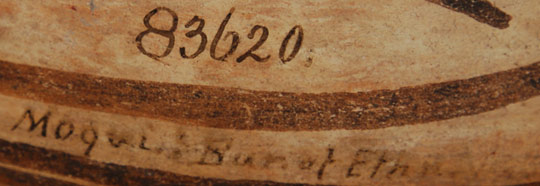Polacca Polychrome “Style C” Bowl, circa 1860-1880 [SOLD]
+ Add to my watchlist Forward to Friend
- Category: Historic
- Origin: Hopi Pueblo, Hopituh Shi-nu-mu
- Medium: Native Clay
- Size: 5” deep x 11” diameter
- Item # C2391.3 SOLD
Polacca pottery style began around 1740. It did not fully become the predominant type at Hopi until about 1800, and it continued until about 1890. Polacca wares were the predominant utilitarian wares of this time period. This bowl is typical of Polacca Polychrome, Style C, which existed in the late-1800s.
Victor Mindeleff at Hopi (Moqui) collected this bowl in 1883 for the Smithsonian. On the interior of the bowl, below the rim, is inscribed, in India ink, 83620 Moqui Bureau of Ethnology.
What we generally consider to be Zuni Pueblo designs were quite prevalent on Polacca vessels. The designs on this bowl are a good example of this. Two major volute design elements fill the interior of the bowl, and a proliferation of feather elements cover the exterior. A red underbody and a black rim complete the decoration.
Condition: The bowl was broken cleanly in half and reassembled without any attempt to conceal the break. A chip to the rim was professionally restored. Breakage on pottery of the significance of this one is not considered to be detrimental. The collection history overshadows the previous breakage which could have happened at the time of collection in 1882.
Provenance: "In 1882, Victor and Cosmos Mindeleff led an expedition to Zuni and Hopi villages to survey archaeological ruins and historic villages.....In November and December 1882 and January 1883, while Victor Mindeleff helped the Stevensons to survey Canyon de Chelly, Cosmos Mindeleff and Cushing traveled to the Hopi reservation and tried to collect on Third Mesa. Experiencing great opposition, they moved to Mishongnovi on Second Mesa and collected over 5000 pots, baskets, household objects, and agricultural tools, 4166 of which were accessioned."
Using the Smithsonian accession number painted on the interior of the bowl, the Smithsonian staff verified for us the bowl to be one of the pieces collected by Cosmos Mindeleff in 1882. The Smithsonian de-accessioned the bowl but their records do not indicate when or to whom. The Smithsonian at that time was overwhelmed with the sheer amount of items being collected in New Mexico and Arizona pueblos that it gave many items to other museums. Over the years, these museums have de-accessioned some of those items which accounts for their being on the market for sale.
Quotation from "The Formation of Ethnographic Collections: The Smithsonian Institution in the American Southwest," by Nancy J. Parezo, in Advances in Archaeological Method and Theory, 10, Michael B. Schiffer, editor (1987): 1-47.
Recommended Reading: Canvas of Clay by Edwin Wade and Allan Cooke

- Category: Historic
- Origin: Hopi Pueblo, Hopituh Shi-nu-mu
- Medium: Native Clay
- Size: 5” deep x 11” diameter
- Item # C2391.3 SOLD


